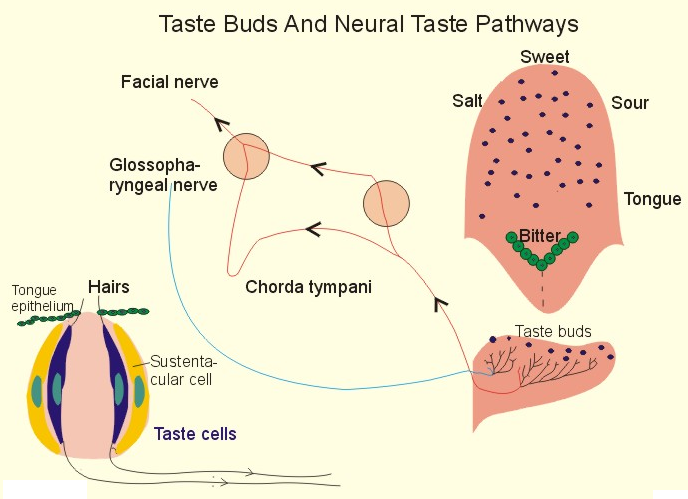Taste pathways
The taste system is defined by its particular peripheral receptors and central pathways which process and relay taste information. Peripheral taste receptors are found on the upper surface of the soft palate, tongue, pharynx, and the upper portion of the esophagus. Taste cells synapse with prime sensory axons which run in the chorda tympani and better superficial petrosal branches of the facial nerve (i.e., cranial nerve VII), the lingual branch of the glossopharyngeal nerve (i.e., cranial nerve IX), and the finer laryngeal branch of the vagus nerve (i.e., Cranial nerve X) to innervate the taste buds in the palate, tongue, epiglottis, and esophagus correspondingly. The central axons of such primary sensory neurons in the respective cranial nerve ganglia project to lateral and rostral areas of the nucleus of the solitary tract in the medulla, that is also known as the gustatory nucleus of the solitary tract complex. Axons from the rostral (gustatory) portion of the solitary nucleus project to the ventral posterior complex of the thalamus, where they finish in the medial half of the ventral posterior medial nucleus. This nucleus projects in turn to numerous areas of the neocortex that involves the gustatory cortex (i.e., the frontal operculum and the insula), that becomes activated whenever the subject is consuming and experiencing taste.

Transduction takes place whenever different taste substances cause a change in the flow of ions across the membrane of a taste cell. Various substances affect the membrane in diverse ways. Sweet and bitter substances bind into receptor sites that discharge other substances into the cell. Sour substances contain H+ ions which block channels in the membrane. Salty substances break up into Na+ ions that flow through the membrane directly into the cell. Electrical signals produced in the taste cells are transmitted in three pathways:
• The chorda tympani nerve conduct signals from the front and sides of the tongue.
• The glosso-pharyngeal nerve conduct signals from the back of the tongue.
• The vagus nerve conduct taste signals from the larynx and the mouth.
These three nerves make connections in the brain stem in the nucleus of the solitary tract before going on to the thalamus and then to two areas of the frontal lobe (i.e., the insula and the frontal operculum cortex).